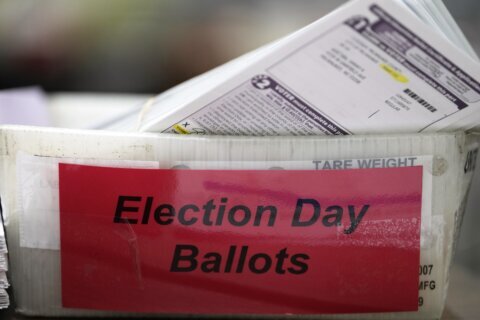It was a long and lonely day for many of the people serving as election judges in Maryland’s presidential primary, with low turnouts reported across the state for in-person voting.
According to the early election results from the Maryland State Board of Elections, a combined 722,009 votes were cast in the primary election, which translates to just under 20% of registered voters. That number includes the first round of mail-in ballots, early voting and election day turnout.
Todd Eberly, professor of political science and public policy at St. Mary’s College of Maryland, told WTOP there were more than 1 million votes cast in the primary in 2022. Noting the current preliminary figure of votes cast, Eberly said, “There would have to be a lot mail-in ballots still sort of hanging around out there to get us past where we were in 2022.”
Eberly said there is the sense that turnout was depressed because the presidential contest was settled by the time Marylanders got to cast their votes.
- Maryland Senate primary: Alsobrooks defeats Trone in race for Democratic nomination; Hogan wins GOP nod
- Maryland’s 6th District: Neil Parrott scores GOP nomination; early lead for April McClain Delaney tips Democratic nod
- Maryland vote breakdown: Where Alsobrooks won big, where Trone had the edge — and how Hogan did
- 2024 Maryland primary results: U.S. House, Senate, presidential primary
- 2024 Maryland primary: Local primary election results
Ian Anson, associate professor of political science at the University of Maryland, Baltimore County said he believes that’s a factor. “With Joe Biden and Donald Trump being the presumptive nominees, there wasn’t that much to motivate voters to make a national decision in that sense.”
Anson and Eberly also said the primary election calendar plays a role as well.
“People are not always aware of the date of the primary, but they tend to be aware that elections in the general tend to happen late in the year.”
Eberly added, “I think that if Maryland really wants to have more turnout, and even have a say in what’s happening in nominating presidents, they’ve got to have their primary sooner.”
Another issue that may be at play, said Anson, is the variety of methods that Marylanders can use to cast their ballots. They can vote by mail, take part in eight days of early voting, or show up on primary day. And while the choice would seem to invite greater participation, that’s not necessarily the case.
Anson said voters tend to lean into their voting habits. The 2020 election was mail-in only, and that method seems to have caught on — with nearly 600,000 voters requesting mail in ballots for the primary. Anson said, “Voters are habitual, and they like to develop a regular habit for voting. And with all these kind of new post-COVID methods for voting,” voters are having to sort through the different timelines and processes for voting.
Eberly agreed, saying, “The same people who would have turned out anyway are just turning out in one of the different ways that’s available to them.”
Eberly said primary voters tend to follow politics closely and remain committed to casting their ballots in the early races.
“Among those folks, they were paying attention, they knew which races matter, and they turned out. But that’s just not a big chunk of the electorate” he said.
Both Eberly and Anson said while the primary turnout may have been low, the general election turnout is expected to be much more robust.
Despite the hotly contested congressional races in the Maryland primary, “It’s really presidential politics and gubernatorial politics that tend to galvanize our voters,” Anson said.
Eberly said there’s been a trend of low turnout in primaries and higher turnout in national elections.
“Unfortunately, that’s a reflection of how polarized we’ve become, because everybody wants to get out and vote against the other guy.”
The results of the primary won’t be official until certified on May 24.
Get breaking news and daily headlines delivered to your email inbox by signing up here.
© 2024 WTOP. All Rights Reserved. This website is not intended for users located within the European Economic Area.








